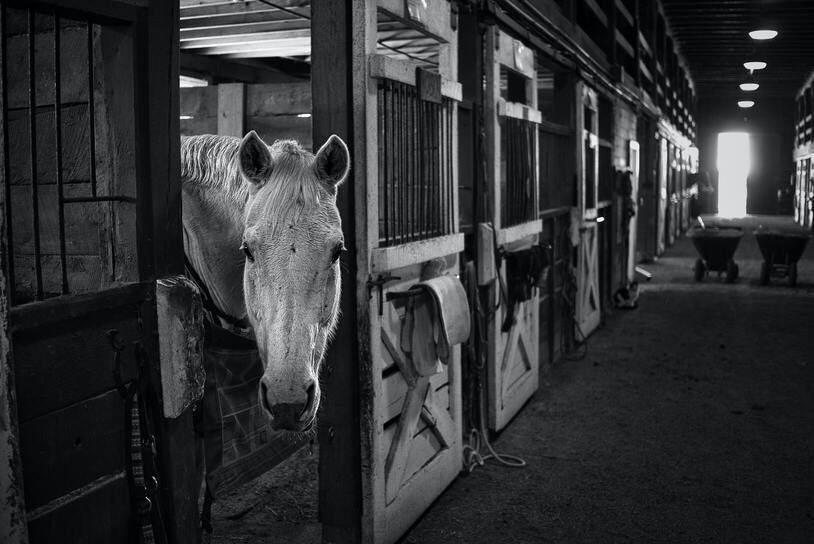Bills - particularly electricity and fuel- have been increasing rapidly in recent weeks with many yard owners finding that this is directly affecting the running costs of their equestrian premises. For those who employ staff, the increase of the National Minimum Wage (NMW) this spring will be a further hit to running costs. To make an effective change on your incomings versus the raised outgoings, it’s likely you will need to increase the price of your livery packages and services.
First and foremost, before any price changes, it is important to
carry out a review of your own costs. Whilst it would be easy to think that yards in the same area offering the same packages would be able to compare running costs, and therefore prices, they can be very different when it comes to their outgoings and business structure. It is therefore imperative that all yard owners should be aware of their own running costs to determine their price per stable, including every single one of their costs- many of which are often overlooked. Yard owners should ensure that they carry out a review of their costs at least annually and in situations such as we’re experiencing currently, to do so on a more regular basis to ensure any price increases from your suppliers are being reflected in what you charge within a reasonable time frame.
Whilst many yard owners do not like increasing prices for fear of losing clients, ultimately those who fail to increase their prices beyond their costs simply end up operating at a loss and subsidising the hobby of their livery clients! Raising your livery prices does not need to be a painful exercise: It is much better to be organised and have an annual price increase
included in your livery contract rather than a large jump in livery prices when needs must every few years. This way you will be able to apply a small annual price increase to keep in line with increased running costs, and it’s both expected and pre-agreed to by your clients. Incremental price increases that are expected are therefore better received by livery clients and easier on the purse meaning a higher likelihood of client retention. You should make sure that any price increases are dealt with professionally, ideally in writing to all liveries at the same time by sending out a formal
Notice of Price Increase letter. The notice given of a price increase should match your notice period to terminate a contract. For example, if your notice period to terminate a livery contract is 30 days then the same notice period should be given for any price rise that you intend to do. You should ensure that the price increase applies to all liveries and any subsequent liveries arriving on the yard with no special arrangements or dispensation for certain clients.

It is best to keep the price increase notice short and to the point. Everybody knows that prices rise, and horse owners should not expect the owners of livery yards to be exempt from this. There is no need to go into lengthy detail about how or why you concluded the amount of your price increase, or to give figures of running costs. You would not ask your hairdresser or plumber for a breakdown of costs if they chose to put up their prices! It is best to simply state that your running costs have increased, requiring you to reflect this by raising your prices accordingly. A good point to make is simply that raising prices in line with your costs ensures you can continue offering the same level of service and quality of care expected by your livery clients.
If you are not sure how to deal with an annual price increase it is easy to add a clause into your
livery contract of an estimated annual price increase on a set date. The annual government inflation rates, or
Consumer Prices Index to be more specific, are a good place to start which are often around 2 to 3% annually. This means products and services raise roughly this amount each year, mostly familiar to homeowners as an increase in utility bills, insurance premiums, fuel, and the weekly shop. This inflation rate is what we’d usually recommend as a basic price increase included in livery contracts. However, its important to make sure this is not fixed as both your running costs and inflation can vary depending on the economy and a 2-3% increase may not adequately cover your rise in costs over the period of a year, as is being experienced right now by the huge hikes in some bills. In fact, due to Covid and other resulting issues, the government inflation rate is currently sitting at 5.5%. Whilst this is likely to lower again as situations improve, this again proves why it is important to calculate and review your costs regularly, and certainly prior to any price increase.
Just a small price increase for each client can have a beneficial financial impact for you. Even a £5 per week increase on livery charges (obviously the percentage and actual amount will depend on your livery fees, but as an example) will on a 10-box yard generate almost an extra £220 per month to help towards running costs. And the price increases should not be exclusive to livery charges but think about increasing the price across your range of services from livery to instruction, facility hire, and even ad-hoc services such as holiday cover and exercise.
OUR TOP TIPS FOR PRICE INCREASES:
Calculate Your Costs: Do not just assume a price increase. You need to properly calculate your costs to ascertain how much you need to raise your prices by.
Put it in Writing: Notify your clients in writing, explaining the rise concisely, stating what the price increase will be and when it comes into effect.
No Need to Explain: You do not need to provide a lengthy explanation or any costings as to why you are raising your prices. Other than that you are doing so to ensure you continue to offer the service is expected of you by your clients.
Don’t Panic about Losing Liveries: You cannot hold off on raising prices just to keep the client content, as ultimately you will be the one who loses out on money.
Empty stables will fill again, and more often than not horse owners are understanding and accepting of price increases.
Put it in Your Contract: Having an annual price increase as a specific clause in your livery contract makes it much easier to implement as well as being expected by your clients.
Do it now: Too many yard owners take a long time deliberating whether to raise prices or not. The huge hikes in costs over recent months mean that they can no longer be avoided. There is no good time to tell people the cost is rising for their livery, so there is no time like the present!

In 2019, as part of our
Yard Owner Hub, LiveryList launched a
Livery Charges Calculation Sheet as an aid to help yard owners
better understand their running costs, and everything that needs to be included when you’re calculating your cost per stable. This includes a detailed list of costs to consider, many of which are often overlooked and should be included in your calculations. When you work out your costs it is also important to allow a contingency of around 10%. This will go a little way towards covering any interim price increases from your suppliers and can also allow for times that you may have a stable empty and are not earning any income. The Livery Charges Calculation Sheet is free to access and is easy to understand and complete, taking about 30 minutes if you have the necessary information at hand. Often even a quick glance through the sheet can make yard owners realise that there are costs they omit, not least an allowance for their very own labour!
The resource has been used by hundreds of yard owners as a useful tool to not only compare their running costs to what they charge but also to enable regular reviews and to keep on top of being a sustainable and viable business. This, and hundreds of other templates and resources, are available free of charge on the
LiveryList Yard Owner Hub, brought to you in partnership with Lingfield Equine Distance Learning. We also run a friendly and supportive
Yard Owner Discussion Group on Facebook if you’d like to share advice and experiences with like-minded and friendly yard owners.



